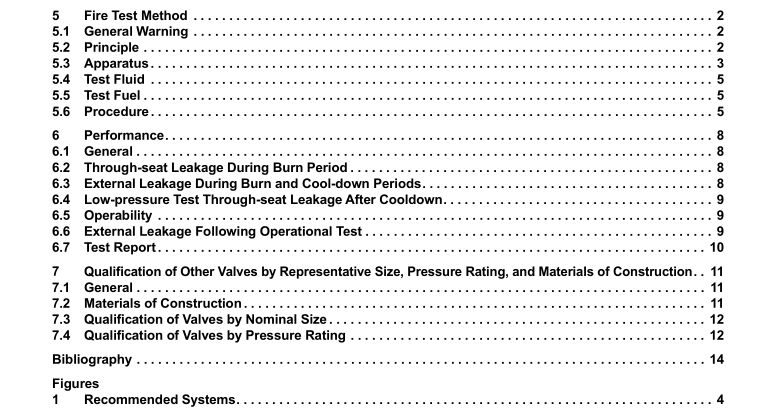API St 607:2016 pdf free download.Fire Test for Quarter-turn Valves and Valves Equipped with Nonmetallic Seats
5.6.1 Mount the test valve in the test apparatus so that the stem and bore of the valve are in the horizontal position. Mount a valve that operates in only one direction (unidirectional) in their normal operating position. Locate the flame environment, body thermocouples, and calorimeter cubes in the positions shown in Figures 3 and 4, as appropriate. For nonmetallic seated valves up to DN 1 00 or NPS 4 and pressure ratings up to Class 300, use two flame environment thermocouples and two body thermocouples and calorimeter cubes as shown in Figure 3. For all other valves, use two flame environment thermocouples and two calorimeter cubes as shown in Figure 4. For valves DN 200 or NPS 8 and larger, use the third calorimeter cubes as shown in Figure 4.
5.6.2 With the test valve in the partially open position, open the water supply valve (5), the shut-off valve (6), the vent valves (1 6), and the shut-off valve (1 5) to flood the system and purge the air. When the system is completely filled with water, close the shut-off valve (1 5), the vent valves (1 6), and the water supply valve (5). Pressurize the system with water to a test pressure of 1 .4 times the maximum allowable working pressure at 20 °C (70 °F)—the actual test pressure may be rounded up to the next highest bar 1 . Check for leaks in the test apparatus and eliminate as necessary. Release the pressure, close the test valve, and open the shut-off valve (1 5).
5.6.3 If the valve under test is of the upstream sealing type, determine the volume of water that is trapped between the upstream seat seal and the downstream seat seal when the valve is closed. Record this volume. It is assumed that, during the fire type-test, this volume of water will flow through the valve and pass the downstream seat seal to be collected in the container (1 8). Since this volume has not actually leaked through the upstream seat seal, it is deducted from the total volume collected in the downstream container when determining the through-seat leakage (see 5.6.1 1 ).
5.6.4 Pressurize the system to one or the other of the following pressures, as appropriate: a) for nonmetallic seated valves rated Class 1 50 and Class 300, the low test pressure at 0.2 MPa (30 psig); b) for all other valves, the high test pressure at 75 % of the maximum permissible seat working pressure at 20 °C (70 °F). Maintain this test pressure during the burn and cool-down periods, momentary pressure losses of up to 50 % of the test pressure being permitted provided that the pressure recovers within 2 minutes and the cumulative duration is less than 2 minutes.
5.6.5 Record the reading on the calibrated sight gauge or device (4). Empty the container (1 8).
5.6.6 Adjust the test system, excluding the test valve, during the test period to maintain the temperatures and pressures required.
5.6.7 Open the fuel supply, establish a fire, and monitor the flame environment temperature throughout the burn period of 30 minutes, +5, −0 minutes. Check that the average temperature of the two flame environment thermocouples (1 3) reaches 750 °C (1 400 °F) within 2 minutes from the start of the burn period, i.e. from ignition of the burners. Maintain the average temperature between 750 °C and 1 000 °C (1 400 °F to 1 800 °F), with no reading less than 700 °C (1 300 °F) for the remainder of the burn period of 30 minutes.
5.6.8 If cavity pressure exceeds the stated manufacturer’s allowable pressure, the test shall end and be reported as an invalid test.
5.6.9 The average temperature of the calorimeter cubes shall be 650 °C (1 200 °F) within 1 5 minutes of starting the burn period. For the remainder of the burn period, maintain the minimum average temperature of 650 °C (1 200 °F), with no temperature falling to less than 560 °C (1 000 °F). For valves subjected to the low-pressure test (see 5.6.4), the body thermocouple shall maintain 590 °C (1 1 00 °F) for at least 5 minutes and the bonnet thermocouple shall maintain 650 °C (1 200 °F) for at least 1 5 minutes of the burn period. The burn period may be extended by up to 5 minutes in order to achieve this requirement.API St 607 pdf download.API St 607:2016 pdf free download
